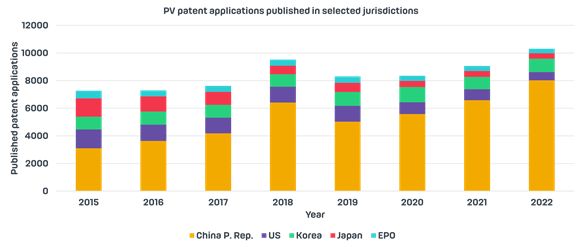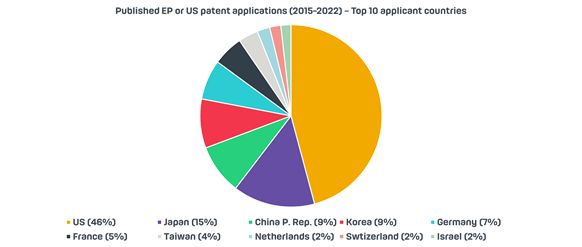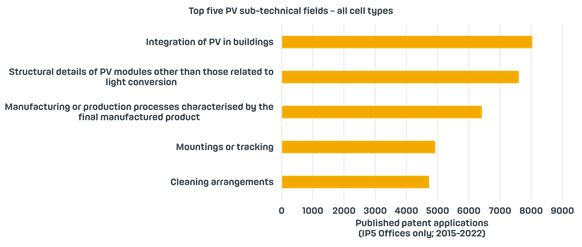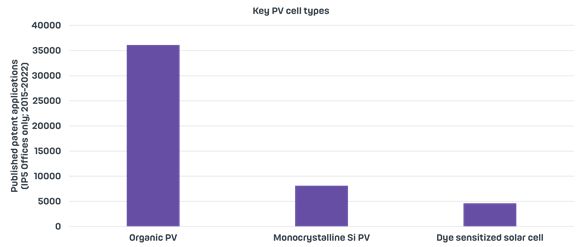Harnessing solar energy, our most abundant renewable energy resource, has enormous potential for climate change mitigation.
Solar photovoltaic, PV, technologies will play a central role in this harnessing, and its characteristics and near-term forecasts are encouraging.
In particular, solar PV exceeded 1000 TWh of electricity generation for the first time in 2021, or 3.6% of worldwide electricity generation. According to the International Energy Agency, IEA, the installed capacity of solar PV is set to exceed that of coal by 2027, becoming the largest source of power capacity in the world.
Against this backdrop, we cast a spotlight on areas of solar PV innovation.
EMERGING PV TECHNOLOGIES
The mainstay semiconductor of the PV industry is silicon, accounting for over 95% of total production in 2021. Thin-film technologies such as copper indium gallium selenide, CIGS, are also relatively established.
Innovation on emerging PV technologies nonetheless continues to grow. Motivating factors include the potential for lower costs, higher efficiency, and/or an expansion of photovoltaics into new areas such as agrivoltaics and building-integrated PV.
Emerging PV technologies include dye-sensitized solar cells, organic PV, and perovskite PV, each of which is relatively inexpensive to produce and can be tailored (e.g., through semiconductor design) to their end application.
In turn, these emerging technologies support the development of advanced concepts of solar energy harvesting, such as spectral conversion (up- or down-converting incident light to wavelengths matched with the bandgap of the utilised semiconductor) and tandem PV, where at least two different solar cells with complementary absorption properties are stacked together to maximise harvesting of sunlight.
SMART SOLAR SYSTEMS AND DIGITAL INNOVATION
Insight from the European Patent Office on renewable energy innovation highlighted smart solar systems as one area of continued rapid growth.
Example sub-areas include:
- power management;
- sun tracking;
- smart grids, including planning for future energy requirements;
- movement of light concentrators;
- detection of malfunctions; and
- measuring and addressing soiling or other environmental stress factors.
These sub-areas are independent of the types of materials used in a PV cell and are therefore applicable to both traditional and emerging PV technologies.
Solar PV innovation also benefits from digital innovation, including the application of AI. Examples in this space include processing optimization and output forecasting, which overlap with the sub-areas discussed above.
SUSTAINABILITY
Growth of solar PV to the capacity levels forecast by the IEA, and beyond, is driving innovation on sustainable manufacturing and closed-loop recycling.
Recent work by a team at the US National Renewable Energy Laboratory highlighted the following trends within the PV circular economy:
- Long-lived modules reduce demand for new material and provide a longer grace period to develop and implement end-of-life recycling or remanufacturing processes.
- Shorter-lived modules must achieve high rates of recollection and recycling/remanufacturing to avoid consuming additional new materials.
- Glass composes the majority (by mass) of today's PV modules, and so represents a key consideration when developing recycling or remanufacturing processes.
Innovation on materials and processes, e.g., to minimise and/or recover the use of scarce or toxic materials, goes hand in hand with the above.
PATENTING TRENDS IN PV
A snapshot of PV patenting trends can be obtained by considering published patent applications classified under entry Y02E 10/501 of the Cooperative Patent Classification, CPC, system (data source: PatBase).
As seen from Figure 1, Chinese patent applications made up an overwhelming proportion of PV patent applications published from 2015 to 2022, while patent applications in the other major patent jurisdictions experienced either relative stability or a decline.
Figure 1

The disparity between Chinese PV filings and PV filings for other major patent jurisdictions correlates with China's >80% share (as of 2022) in all the manufacturing stages of solar panels. As such, it remains to be seen whether, in response to calls to move solar PV production closer to the point of installation, the disparity will close over the coming years.
The large number of Chinese PV filings may also hide information on where PV innovation takes place. To account for this, Figure 2 provides an alternative perspective on patenting trends in PV compared to Figure 1, by providing a breakdown of the top 10 countries (as a proxy for the location of innovation) of applicants seeking patent protection in Europe or the US.
Figure 2

As an applicant country, China ranks third according to this data, behind the US and Japan. Also, European applicants file fewer EP or US patent applications than their Asian counterparts.
Returning to the data behind Figure 1, Figure 3 compares the number of published PV patent applications for the top five PV sub-technical fields for all cell types2. The leading sub-field by filings relates to the integration of PV in buildings.
Figure 3

Figure 4 shows an alternative comparison to Figure 3, specifically by looking at filings for key PV cell types3.
Figure 4

According to this comparison, patent filings for organic PV show a large lead over monocrystalline Si PV and dye-sensitized solar cells. Such a lead includes a contribution from patent filings for perovskite PV4 but nevertheless evidences greater innovation in recent years on emerging PV materials compared with a mainstay semiconductor.
OUTLOOK
As evidenced above, solar PV is a rich, multi-disciplinary technology field. With this technology set to play a key role in electricity generation over the coming decades, we expect IP rights, and awareness thereof, to become more important for PV stakeholders to:
- meet commercial objectives.
- attract investment.
- conduct due diligence and Freedom to Operate.
In our next article we will look at the various forms of patent claim available for PV innovations, alongside top tips for seeking patent protection.
Footnotes
1. Namely Reduction of Greenhouse Gas [GHG] Emissions, Related to Energy Generation, Transmission or Distribution / Energy Generation Through Renewable Energy Sources / Photovoltaic [PV] energy.
2. From top to bottom, sub-classes Y02B10/10, H02S20/30, Y02P70/50, Y02E10/47 and H02S40/10.
3. From left to right, sub-classes Y02E10/549, Y02E10/547 and Y02E10/542.
4. See, e.g., EP 3084854 A1 and EP 3149765 A2.
The content of this article is intended to provide a general guide to the subject matter. Specialist advice should be sought about your specific circumstances.



